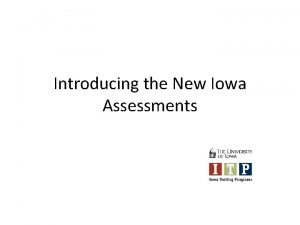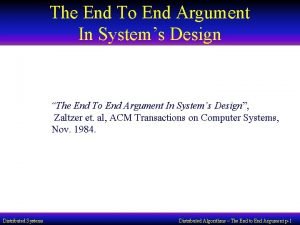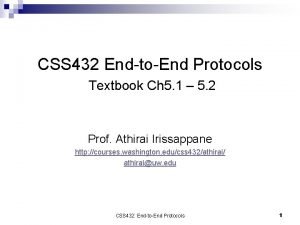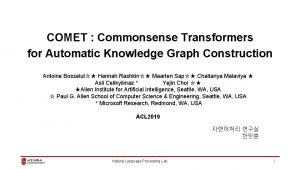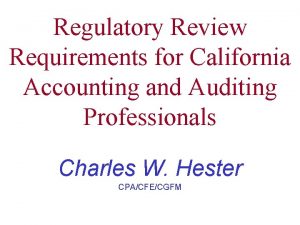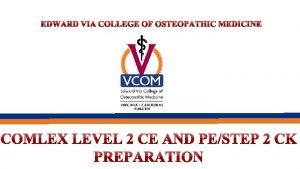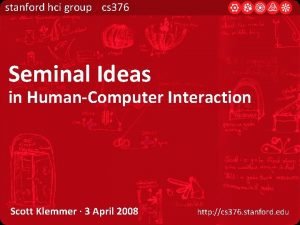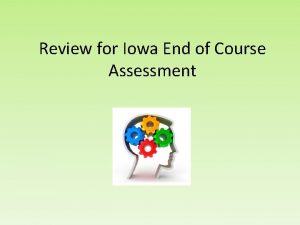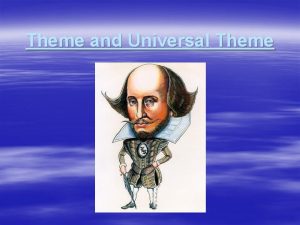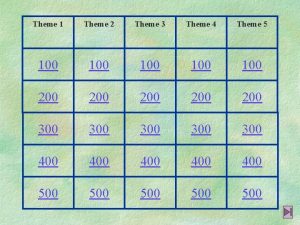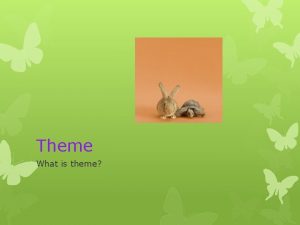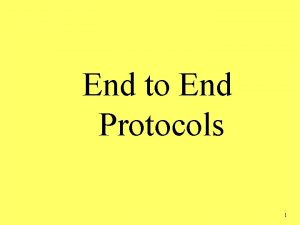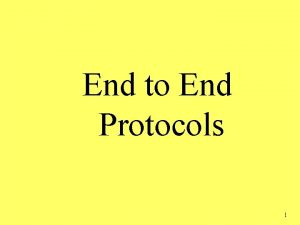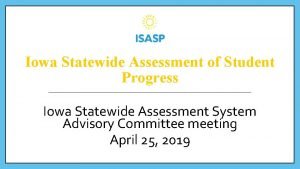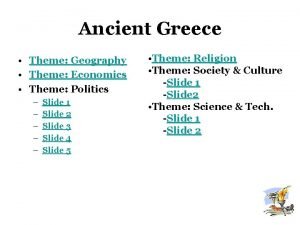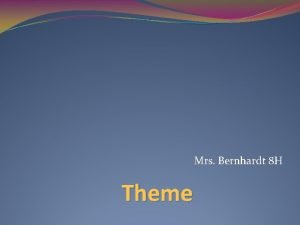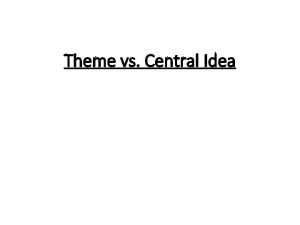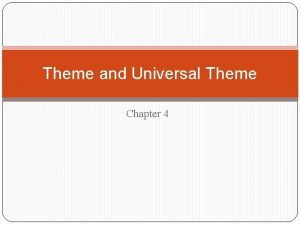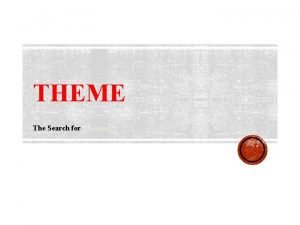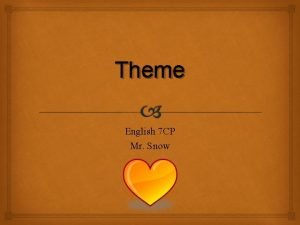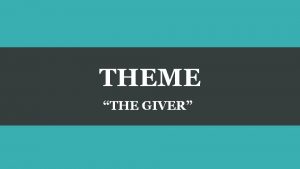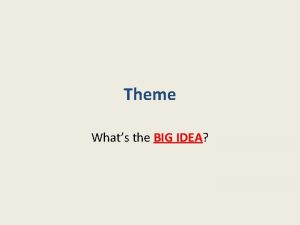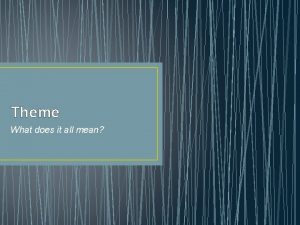Review for Iowa End of Course Assessment Theme
























- Slides: 24

Review for Iowa End of Course Assessment

Theme What is theme? • The central idea or message of a story, poem, or play. • Usually can be stated in general terms. • Usually not stated word for word in the story.

Theme Give some examples of ways we find theme in poems, short stories, and plays. • • • Title Symbols Character Change Conflict & Resolution Tone Shift

Symbols What are some examples of symbols (broad categories)? • • • People or animals Settings Objects Names Colors

Tone What is tone? • The author’s attitude towards the subject. • Usually stated with one word descriptions: – Sad or Happy – Longing – Melancholy – Reminiscent – Regretful

Tone What do we mean when we talk about “tone shift”? • Tone shift is when the poem, story, or play shifts from one to another part way through the passage. – Ex. A story might start out happy, but end tragically. – Where else might a reader find a tone shift?

Tone How does diction help determine tone? • Diction (a. k. a. word choice) provides the reader with different connotations depending on the word chosen. – Ex. The word happy has one connotation, the word joyful another, and the word ecstatic another. – Explain the different connotation of each word.

Point of View What are the different points of view an author may use? • First Person-views action through main character’s eyes • Third Person Limited-follow one character, view is limited to what is happening to that character • Third Person Omniscient-know thoughts and feelings, observe more than one character or location

Types of Characters Define protagonist and antagonist. • Protagonist-the main character, or hero, of a story • Antagonist-any character who opposes the protagonist

Irony What are three types of irony? • Verbal • Dramatic • Situational

Miscellaneous Terms What is an “allusion”? • A reference to mythology, history or religion in a literary work. What are the different types of figurative language? • Idiom-a figure of speech that means something different than the words that are actually said • Metaphor-a comparison between two things not using “like” or “as” • Simile-a comparison between two things using “like” or “as” • Personification-giving human characteristics to inanimate objects

Miscellaneous Terms What is imagery? • Language that appeals to one or more of the five senses – Taste, touch, sight, sound, smell What is the difference between hyperbole and understatement? • Hyperbole is deliberate exaggeration – Ex. “I had a million things to do things morning!” • Understatement is a type of irony that shows things as less than they are – Ex. “I guess I could manage to get by with 10 million dollars a year. ”

Identify the Tone “Now is the time for all Americans to go to the polls and vote! Our nation is on the brink of potentially far-reaching economic disaster if there is no change in the current practices of our government. It is your duty as an American citizen to exercise your right to vote and demand the changes you know are necessary. The time for action is NOW!”

Read the poem and then answer the questions. The Skater She was all in black but for a yellow ponytail that trailed from her cap, and bright blue gloves that she held out wide, the feathery fingers spread, as surely she stepped, click-clack, onto the frozen top of the world. And there, with a clatter of blades, she began to braid a loose path that broadened into a meadow of curls. Across the ice she swooped and then turned back, and, halfway, bent her legs and leapt into the air the way a crane leaps, blue gloves lifting her lightly, and turned a snappy half-turn there in the wind before coming down, arms wide, skating backward right out of that moment, smiling back at the woman she’d been just an instant before. ---Ted Kooser • • Are there any symbols? What image is created? Note any figurative language. What tone is conveyed in the following words: “trailed”, “feathery”, and “leapt”?

Read the poem and then answer the questions. The City In the morning the city Spreads its wings Making a song In stone that sings. In the evening the city Goes to bed Hanging lights Above its head. --Langston Hughes • What is the tone in the first stanza? • What is the tone in the second stanza? • What does this tone shift tell us about theme of the poem?

Compare the tone and the use of symbols in the following two poems. A Painting One Day Your Unfinished Painting I saw a painting one day. It was very pleasant, very colorful. So colorful and pleasant in fact, it reminded me of spring. Beautiful like spring season, the painting was happy and calm and fresh and so reminded me of the beauty of change. I stare at your unfinished painting. Its thick, yellow-blue splatters of paint, Its purple-pink brush smears. I stand staring silently, letting the turpentine smell of sticky oil paint slide in through my nostrils. I close my eyes and think of March, think of snow melting, pooling alongside street curbs, mixing with steaming gas-oils, and smile.

What does the title of these two poems tell us about their theme? In a Station of the Metro The apparition of these faces in the crowd; Petals on a wet, black bough. --Ezra Pound Apartment House A filing cabinet of human lives Where people swarm like bees in tunneled hives, Each to his own cell in the covered comb, Identical and cramped -- we call it home. --Gerald Raftery

Read the following quotes and discuss why they demonstrate irony. Which type of irony do they demonstrate? “I said to him, ‘My dear Fortunato, you are luckily met. How remarkably well you are looking today!” ~The Cask of Amontillado “I passed down a long and winding staircase, requesting [Fortunato] to be cautious as he followed. ” ~The Cask of Amontillado “’I drink, ’ he said, ‘to the buried that repose around us. ’ ‘And I to your long life. ’” ~The Cask of Amontillado

“For there lay The Combs--the set of combs, side and back, that Della had worshipped for so long in a Broadway window. Beautiful combs, pure tortoise shell, with jewel rims—just the shade to wear in the beautiful vanished hair. ” ~The Gift of the Magi “But in a last word to the wise of these days, let it be said that of all who give gifts, these two were the wisest…. They are the Magi. ” ~The Gift of the Magi

• What are some examples of irony in Romeo and Juliet? • What difference does it make that To Kill a Mockingbird is told through the eyes of Scout? • What character role is Odysseus from The Odyssey? (Hint: another word for hero)

Read the passage and answer the questions that follow. “Do you remember that diamond necklace you loaned me to wear to the dance at the Ministry? ” “Yes, but what about it? ” “Well, I lost it. ” “You lost it! But you returned it. ” “I bought you another just like it [which cost four thousand francs]. And we’ve been paying for it for ten years now. You can imagine that wasn’t easy for us who had nothing…” “Oh, my poor Mathilde. But mine was only paste. Why at most it was worth only five hundred francs!” ~excerpt from “The Necklace”

• What type of irony is displayed in this excerpt? • What do you think the meaning of “paste” is from the context of the passage? • This excerpt is taken from “The Necklace” which tells the story of a very poor woman who borrowed a diamond necklace from her friend, lost it, replaced it to cover her mistake, and spent the next ten years even poorer than she started because of her debt. Looking at this excerpt (the ending of the story), what lesson do you think the author intended his reader to learn?

Tips for Test-Taking • You will need to use the following skills: – Careful reading – Text analysis (elements of fiction) – Inferential thinking – Non-fiction reading skills – Process of elimination with multiple choice questions – Patience with the computers

Good Luck! Give your best effort!
 Hbs final exam practice test
Hbs final exam practice test Iowa staewide assessment of student progress
Iowa staewide assessment of student progress One and half brick wall
One and half brick wall Course title and course number
Course title and course number Course interne course externe
Course interne course externe Stroke volume definition
Stroke volume definition Stroke volume normal
Stroke volume normal Front end of a compiler
Front end of a compiler Back end of the compiler performs
Back end of the compiler performs Kolondivertikulose
Kolondivertikulose End-to-end wireframe parsing
End-to-end wireframe parsing End to end argument
End to end argument End to end accounting life cycle tasks
End to end accounting life cycle tasks Protect
Protect End to end delay
End to end delay End to end
End to end Comet nlp
Comet nlp End-to-end procurement life cycle
End-to-end procurement life cycle Pediatric board review courses
Pediatric board review courses Asam review course
Asam review course Ca regulatory review course
Ca regulatory review course Allergy board review course
Allergy board review course Comlex level 2
Comlex level 2 Stanford hci
Stanford hci Fspos
Fspos

